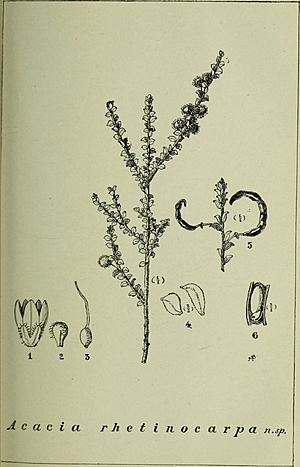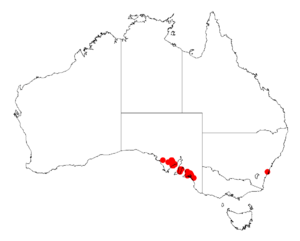Neat wattle facts for kids
Quick facts for kids Neat wattle |
|
|---|---|
 |
|
| Botanical illustration from Transactions and proceedings and report of the Philosophical Society of Adelaide, South Australia in 1920 | |
| Conservation status | |
| Scientific classification | |
| Genus: |
Acacia
|
| Species: |
rhetinocarpa
|
 |
|
| Occurrence data from AVH | |
Acacia rhetinocarpa, also called the neat wattle or resin wattle, is a special kind of shrub. It belongs to the Acacia family, which is well-known in Australia. This plant grows naturally in southern Australia. Since 2013, it has been listed as a vulnerable plant. This means it needs protection because its numbers are getting low.
Contents
What Does Acacia rhetinocarpa Look Like?
This shrub is often sticky, like it has resin on it. It usually grows to be about 0.5 to 2 meters (1.6 to 6.6 feet) tall. Its small branches are yellowish to light brown. They might have a few hairs and get darker closer to the ground.
The leaves of this plant are not typical leaves. They are flat, leaf-like stems called phyllodes. These phyllodes are green and have a unique shape. They are often wider at the top, like a triangle or an oval.
Flowers and Seed Pods
The neat wattle usually blooms between August and October. Sometimes, you can see its flowers as late as March. It produces round flower-heads. Each flower-head has about 12 to 15 bright yellow flowers.
After the flowers, straight or slightly curved seed pods grow. These pods are brown and are about 10 to 35 millimeters (0.4 to 1.4 inches) long. They are also quite narrow, only about 2 to 2.5 millimeters (0.08 to 0.1 inches) wide. Inside these pods are shiny brown seeds. The seeds are oblong and about 3.5 millimeters (0.14 inches) long.
How Acacia rhetinocarpa Reproduces
Scientists think that the wind helps to spread the pollen for this plant. This process is called wind pollination. Ants are also very important for spreading the seeds. This is known as myrmecochory, where ants carry the seeds away.
For new plants to grow, the seeds often need a little help. They are most likely to sprout after the ground has been disturbed. This can happen from things like digging or even a bushfire.
Naming and History of Acacia rhetinocarpa
The neat wattle was first officially described in 1920. A botanist named John McConnell Black gave it its scientific name. He wrote about it in a publication called Transactions and Proceedings of the Royal Society of South Australia.
The name rhetinocarpa comes from two Greek words. Rhetine means "resin" or "gum." Karpos means "fruit." This name refers to the sticky, resin-like nature of the plant's seed pods.
Where Acacia rhetinocarpa Grows
This special shrub only grows in a few small areas in southern Australia. You can find it on the Eyre Peninsula near Arno Bay. It also grows on the Yorke Peninsula near Curramulka. Another area where it lives is between the Gilbert River and Monarto.
The neat wattle prefers to grow in sandy soils that contain calcium. It is often found in open scrubland areas. In these places, it grows alongside different types of Eucalyptus trees. The total area where this shrub is found is about 4,976 square kilometers (1,921 square miles).


